
Manufacturer's Specifications:
Frequency Response: 10 Hz to 20 kHz, ±0 dB.
Converter Type: 20-bit, with eight times oversampling.
Analog Stage: Four 12AT7A tubes.
Inputs: One coaxial digital, SPDIF type; three 100-kilohm analog bridging inputs optional.
Output Impedance: 100 ohms.
Dimensions: 19 in. W x 2 in. H x 11 in. D (48.3 cm x 5.1 cm x 27.9 cm).
Weight: 12 lbs. (5.4 kg).
Price: $3,000; preamp version with three analog line inputs, $3,500.
Company Address: 4774 Murietta St., Suite 9, Chino, Cal. 91710.
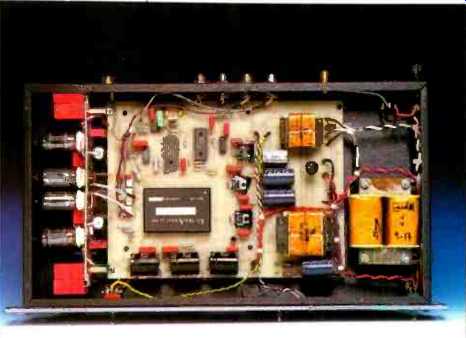
My first experience with Vacuum Tube Logic's D/A converters was with their Reference model, a musically superior device using separate 20-bit D/A converter modules for each channel, which costs exactly twice as much as the Straight-Line model I tested. In the Straight-Line, both channels share one 20-bit module, but it's the same type as is used in the Reference. The Straight-Line comes in two flavors, the straight D/A converter I tested and a preamp version having three selectable inputs plus balance and volume controls.
On the converter's front panel are a "Program/Mute" toggle switch, a red "Muted" LED, a polarity-reversal toggle switch, a green power-on LED, and a toggle power switch.

On the rear panel are an IEC power connector, a line fuse, pairs of phono jacks for analog tape and main output, a binding post for a ground wire, and a phono jack for digital input. All of the signal connectors are high-quality jacks made by VTL. A p.c. board occupies most of the interior, flanked by the largest of the three power transformers on one side and the four horizontally mounted vacuum tubes on the other.
Circuit Highlights
The Straight-Line provides for one digital input, a coaxial type. A signal-conditioning circuit, consisting of a differential line receiver IC, amplifies and squares up the Sony Philips Digital Interface (SPDIF) input signal and passes it along to the ubiquitous Yamaha YM3623B receiver chip.
This device extracts the clock from the composite SPDIF signal and outputs the serial interface signals necessary to drive the following digital filter. The receiver circuitry used here employs a trick or two I've seen before to help reduce jitter in the recovered signals.
Using eight-times oversampling, an NPC SM5813A chip generates a digital Finite Impulse Response (FIR) linear phase low-pass filter with a sharp cutoff at about 21 kHz to implement the data-reconstruction filter function. The up sampled serial outputs of this filter are applied to the input of an UltraAnalog multi-bit D/A converter module. These converters are hybrid circuits made up of various surface mount integrated and discrete components and are generally acclaimed for their accurate measured performance and sonic qualities. The version used in the Straight-Line is custom-made to VTL specifications. These converters are found in other well-regarded D/A converters, usually with prices above that of the Straight-Line.
The audio output of the D/A is passed along to a passive de-emphasis circuit and then into the tube output amplifier.
This circuit, although not original in concept, is interesting in that it uses a series-connected, push-pull output stage that provides both low output impedance and the ability to drive a load more or less equally for either signal polarity. The first stage is connected as a common-cathode amplifier with an unbypassed cathode resistor and with both elements of the 12AT7A/6201 dual triode paralleled. Plate output of this first stage is capacitor-coupled to the grid of the second stage's upper tube, half of another 12AT7A/6201. Both halves of this 12AT7A are self-biased, with their own cathode and grid leak resistors. The upper tube's grid-leak and cathode resistors tie to the bottom tube's plate, with signal output taken from this circuit node and capacitor-coupled to the analog output jacks. The upper tube's plate is also capacitor coupled to the grid of the lower output tube; the upper tube's plate resistor has a relatively small value, chosen so as to allow just enough signal to be tapped off for the lower tube to work in complement to the upper one, allowing loads to be driven symmetrically.
The power-supply circuitry starts out with three separate power transformers. One is used for the tube output amplifiers. The circuitry here consists of two unregulated capacitor-input and RC-filtered supplies, one for the tube heaters and the other for the high-voltage B+. Both channels are powered from the same high-voltage supply. Another power transformer provides unregulated ±20 V and is regulated down to ± 15 V for the analog circuitry in the Ultra Analog module. Main filter capacitors for these supplies are close to 10,000 µF per supply-an amount often used in transistor power amplifiers! The third and final power transformer provides about +9 V to a main digital 5-V regulator. This regulator provides +5 V for the input buffer, the receiver chip, and the digital low-pass filter. Two other +5 V regulators fed from the analog + 15 V supply develop +5 V for the Ultra Analog module.
Measurements
Output level from the main outputs at digital full scale was about 1 V per channel. Frequency response is shown in Fig. 1. The frequency response with an IHF load was as shown in the figure except for a level drop of less than 0.1 dB. Output impedance, although not measured, was quite low.
Impulse and square waves (not shown) were typical of the NPC SM5813A FIR low-pass filter used in this and other converters; this filter exhibits linear phase characteristics and clips the ringing on full-scale square waves at the full-scale point to leave only those portions of the ringing that point toward the "0" line.

Fig. 1--Frequency response, measured at main outputs. Solid curve is left
channel, dash curve is right charm.
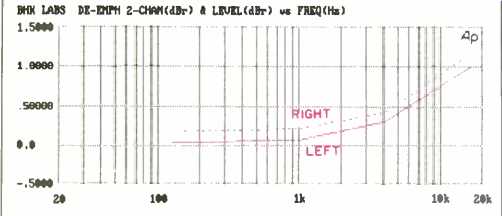
Fig. 2--De-emphasis error.
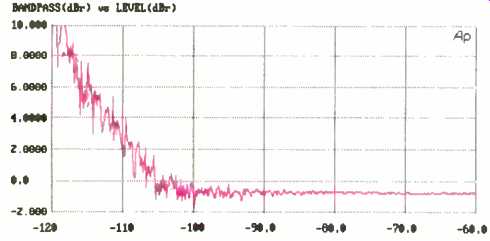
Fig. 3--Fade-to-noise linearity test.
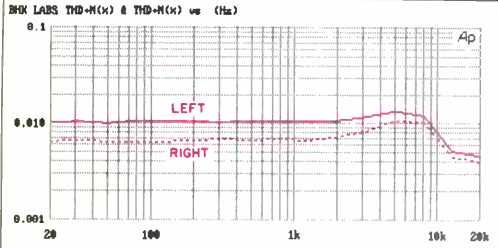
Fig. 4--THD + N vs. frequency at 0-dB (maximum) recorded level. Readings
above 10 kHz are attenuated by the 22-kHz low-pass filter used in this test.
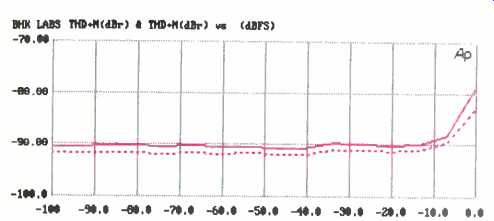
Fig. 5--THD + N vs. recorded level at 1 kHz (-90 dB = 0.003%).
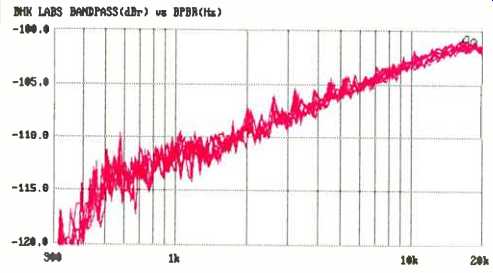
Fig. 6-Quantization spectrum vs. recorded level; see text.
Output from the tape jacks was somewhat lower, about 700 mV, with a quite high output impedance of nearly 20 kilohms. Surprisingly, frequency response into the IHF load was about the same as shown in Fig. 1, though it should have shown more roll-off due to the low-pass filter formed by the IHF load's 1,000 pF of capacitance against the equivalent resistance of the output impedance and the load.
I suspect that the tape output jacks in this sample may have been wired to the wrong part of the circuit. Frequency response at the main outputs with de-emphasis correction switched in is plotted in Fig. 2.
Linearity was measured a number of ways and found to be virtually perfect. Deviation from linearity, using the CBS test disc, is shown in Fig. 3 for the left channel. The plot for the right channel looked just the same except for a little less noise below-100 dB. Distortion as a function of frequency at digital full scale is shown for both channels in Fig. 4. A 22 kHz low-pass filter is used in this test to get the maximum resolution in the audio range. In this unit, the dominant distortion was second harmonic, due to the tube output amplifiers; this causes the curves to show reduced distortion above 10 kHz, because the low-pass measuring filter starts to attenuate the second harmonics of frequencies above this point. Distortion at 1 kHz as a function of digital level is depicted in Fig. 5. Actual distortion decreases quite rapidly into the noise.
Moving along into the area of noise levels, S/N in various bandwidths relative to digital full scale, along with measurements for dynamic range and quantization noise, are listed in Table I. The signal-to-noise ratios are done with the Audio Precision digital generator's signal switched off. The results substantially agree with those derived from the quiet track on the CBS test disc. The dynamic range test measures the A-weighted THD + NI of a 1-kHz signal at-60 dB. This low signal level is used so that, presumably, distortion in the output amplifier of a CD player or D/A converter won't contribute to the reading. The quantization noise test attempts to measure extra noise generated by the workings of the D/A converter. This test uses a full-scale low-frequency signal, such as 20 Hz, the output from which is passed through a 400-Hz high-pass filter (to eliminate the 20-Hz signal and its harmonics) and a 22-kHz low-pass filter (to eliminate noise above the audio passband), leaving only system noise above 400 Hz. As can be seen from the Table, this is higher than the noise between 400 Hz and 22 kHz with no signal present-as is always the case.
Figure 6 shows a new test for checking the spectral content of quantization noise as a function of signal level, devised by Richard Cabot of Audio Precision. This test, like the simpler quantization noise test, uses a 400-Hz high-pass filter and a low modulating frequency of 41 Hz, but with much lower signal level. Low-frequency levels of -60 to -100 dB relative to digital full scale were used in 10-dB steps. The analyzer sweeps its third-octave filter over a range from 300 Hz to 20 kHz and thus displays the spectral content of the quantization noise at the instantaneous modulation level of the 41-Hz signal. Results for each signal level are overlaid on a common graph, as shown. If the spectral content of the noise is constant with signal level, which is desired, the curves will be coincident. This is more or less the case for the VTL Straight-Line. The rise of approximately 3 dB per octave with increasing frequency is caused by the fact that this is white noise, with constant energy in a given bandwidth, whereas the third-octave measuring filter's constant-percentage bandwidth, more appropriate for use with pink noise, makes it see more energy in the third-octave from, say, 3,150 to 4,000 Hz than in the third-octave from 315 to 400 Hz. When this is the case, the measured energy rises at 3 dB per octave.
My final test (not shown) was a third-octave sweep over a wide frequency range, with a 1-kHz signal at -80 dB. Some a.c. line harmonics were visible, and more significant, there was low out-of-band noise above 20 kHz.

Table 1--S/N ratios, referenced to 0-dB recorded level.
Quantization noise was -94.2 dB in the left channel, -95 dB in the right channel. Dynamic range was 98.3 dB in the left channel and 102 dB in the right.
Use and Listening Tests
Ancillary equipment used to evaluate the sound of the Straight-Line converter included First Sound Reference II and Quicksilver preamps to drive several amps, including Quicksilver M-135 prototype mono tube units, a Crown Macro Reference, a prototype digital switching design, and a pair of Carver Silver Sevens. Krell Digital MD-1 and Wadia Digital WS-3200 CD transports fed the SPDIF signal into the D/A converter. Win Research SM-10 monitors and Spica Angelus speakers were used.
I had been using the VTL Reference D/A converter before receiving the Straight-Line unit. I was amazed at how much the Straight-Line sounded like the more expensive converter. I have listened to a number of D/A converters while I have had the VTL units, and while some of them might have had a bit more space or resolution, this was usually accompanied by more irritation. For overall musical satisfaction, I would quickly return to the VTL units. The overall level of sound quality and realism I got using CDs on my system was very, very good. With the Wadia transport feeding the Straight-Line D/A, and using the First Sound Reference II passive preamp feeding the tube amplifiers, I was continually amazed at the level of reproduction attained. Space and dimension were astonishing, and more importantly, tonal balance was realistic. With many pieces of music, the presence of the musicians in the room was palpable.
In conclusion, I think the VTL Straight-Line is a very musical and listenable D/A converter and I really appreciate what it does for digital reproduction in my music system.
The only nit I have to pick is that I wish the output level was more like 2 or 3 V instead of 1 V. I strongly recommend that those looking for an external D/A converter in the Straight Line's price range and who have similar listening priorities to mine go give this VTL a listen.
-Bascom H. King
Also see:
Theta DSPro Prime D/A Converter (Auricle) (Aug. 1992)
Vimak DS-2000 D/A Converter and Preamp (Nov. 1992)
VTL Compact 100 Mono Amp and Deluxe Preamp (Aug. 1990)
(adapted from Audio magazine, Nov. 1992)
= = = =